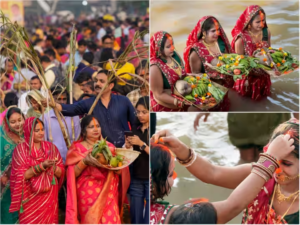
The Chhath Puja has gained much popularity in the state of Bihar in India. It has significant relevance from both the cultural and religious perspective mostly centering on Sun worship.
As a religion, it is observed with a lot of reverence and it is a festival of worshiping the Sun god Surya and Chhathi Maiya the goddess of the Sun. Observed chiefly in Bihar, Uttar Pradesh, Jharkhand, and some parts of Nepal, Chhat Puja is a confluence of rituals and worshiping of the Sun or the source of all energy or life.
It is observed for four days with rigorous fasting, standing in water, and prayers at both dawn and dusk. The principal regenerative rite is the offering of “arghya” (offerings) to the Sun at the time of setting and rising and to the new day that brings life and energy. It lights up, celebrates togetherness, and unites people as families attend this holy festival.
Hence, Chhath Puja is not only a prayer function but also a function of worship, patience and respect with nature.Therefore, cultural and historical relevance defines the existing connection between generations.
It also strengthens the basic human values of communities: faith and devotion. It is massively enthusiastically embraced, thus making it one of the much-anticipated festivals in India.

Chhath Puja In Bihar
Chhath festival of Bihar is bigger and great carnivals where people pay their homage to Surya Devta and Mata Chhathi.It is offered with tremendous devotion, especially in the rural and urban tracts of Bihar where it is one of the major festivals.
The festival is four days long, starting with the Nahay Khay and the Kharna, and the offering of the “arghya” to the Sun as it sets and rises.
Ladies, women especially, are known to go in without eating, standing in water up to their belly button, praying at dusk and dawn in appreciation to sacrifice and providing the Sun God. There is purity, discipline, and respect towards nature dominant in all of the rituals.
Chhath Puja brings families together to perform the purifying rituals. The festival has spiritual sentiments, traditional values, and a love for nature, which makes it an aspect of their culture for Biharis.
Historical And Cultural Significance
Chhath Puja has a great history and is a cultural sentiment in Bihar. In its origin, the festival goes back thousands of years and has been performed from the time of Veda. It is associated with slaying the Sun God Surya which is considered as the emitting power of life energy in Hinduism.
The customs performed during Chhath Puja are unaltered over the years which maintained the traditional bond between humans and the environment.
In cultural terms, Chhath Puja means social respect for natural reagents and aqueous bodies including the Sun, water, and earth. The festival brings unity to the people as everyone participates in the festival rituals.
For the people of Bihar, Chhath Puja is not merely a religious occasion but a cultural festival that acts as an opportunity to unite families and revive basic ideals of today’s society, such as obedience, hard work, and gratitude.

Rituals And Traditions Of Chhath Puja
Like most other traditional Indian rituals, Chhath Puja is a series of well-organized and well-choreographed practices. It takes four days at least, during which purity and devotion, along with respect for nature, are shown. The key rituals include:
1. Nahay Khay (Day 1)
Another practice among devotees consists of ritual washing in a river or a pond that provides purification. From the cultural perspective, they create preparations for the rituals by cooking only pure food and they eat it after they have washed.
2. Kharna (Day 2)
The fasting is done, where the devotees take a meal, a simple one at that in the evening after their prayers for the day. The meal taken is kheer, puris, and fruits and its significance being that the body and mind are purified.
3. Sangranti (Day 3)
A type of prasad or food offering or “thekua,” fruits and other offerings of devotion are then taken to the riversides or ponds. People assemble at dusk and, with respect and prayer, perform “arghya” to the setting Surya.
4. Usha Arghya (Day 4)
The last in order is the rite made in the early morning when the Sun rises. Pilgrims present the sunrise with a water offering known as “arghya” standing in water to receive the divine boon of health, wealth, and prosperity.
Finally it is followed by the breaking of the fast and a lot of rejoicing in the completion of the puja by the family.
These practices are done with a lot of order. Many of the performances involve fasting and prayers, which demonstrate serious commitment and respect to Earth and the God of the Sun.


